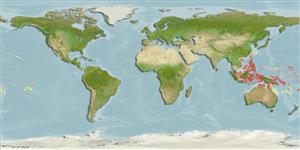Environment: milieu / climate zone / distribuzione batimetrica / distribution range
Ecologia
marino associati a barriera corallina; distribuzione batimetrica 0 - 12 m (Ref. 9710). Tropical
Western Central Pacific: Indonesia, New Guinea, Solomon Islands and Palau in Micronesia.
Size / Peso / Age
Maturità: Lm ? range ? - ? cm
Max length : 11.0 cm TL maschio/sesso non determinato; (Ref. 48636)
Short description
Chiavi di identificazione | Morfologia | Morfometria
Spine dorsali (totale) : 12; Raggi dorsali molli (totale) : 17 - 19; Spine anali: 2; Raggi anali molli: 17 - 20. Identified by the red spots over the back and sides towards the tail, and the large breast spot (Ref. 48636).
Body shape (shape guide): fusiform / normal; Cross section: oval.
Facultative air-breathing (Ref. 126274); Adults are found solitary on coral outcrops (Ref. 90102). They inhabit shallow lagoon reefs, on algal covered rocks and rubble (Ref. 9710). Feed on algae growing at the coral bases. Oviparous. Eggs are demersal and adhesive (Ref. 205), and are attached to the substrate via a filamentous, adhesive pad or pedestal (Ref. 94114). Larvae are planktonic, often found in shallow, coastal waters (Ref. 94114). Maximum depth reported by Ref. 48636.
Life cycle and mating behavior
Maturità | Riproduzione | Deposizione | Uova | Fecundity | Larve
Oviparous, distinct pairing (Ref. 205).
Myers, R.F., 1991. Micronesian reef fishes. Second Ed. Coral Graphics, Barrigada, Guam. 298 p. (Ref. 1602)
IUCN Red List Status (Ref. 130435: Version 2025-1)
Threat to humans
Harmless
Human uses
Strumenti
Special reports
Download XML
Fonti Internet
Estimates based on models
Preferred temperature (Fonte Biblio.
123201): 27.4 - 29.3, mean 28.8 °C (based on 1360 cells).
Phylogenetic diversity index (Fonte Biblio.
82804): PD
50 = 0.5001 [Uniqueness, from 0.5 = low to 2.0 = high].
Bayesian length-weight: a=0.01047 (0.00461 - 0.02381), b=2.98 (2.79 - 3.17), in cm total length, based on LWR estimates for this (Sub)family-body shape (Ref.
93245).
Trophic level (Fonte Biblio.
69278): 2.0 ±0.00 se; based on food items.
Resilienza (Fonte Biblio.
120179): Alto, tempo minimo di raddoppiamento della popolazione meno di 15 mesi (Preliminary K or Fecundity.).
Fishing Vulnerability (Ref.
59153): Low vulnerability (10 of 100).
🛈
Nutrients (Ref.
124155): Calcium = 131 [70, 225] mg/100g; Iron = 0.891 [0.529, 1.461] mg/100g; Protein = 18.4 [17.2, 19.5] %; Omega3 = 0.125 [0.075, 0.206] g/100g; Selenium = 20.7 [11.5, 39.8] μg/100g; VitaminA = 113 [33, 391] μg/100g; Zinc = 2.5 [1.7, 3.6] mg/100g (wet weight);
